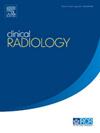Relationship between bone marrow fat fraction and risk of anaemia in patients with Crohn's disease: a cross-sectional study based on chemical shift-encoded magnetic resonance imaging (CSE-MRI)
IF 2.1
3区 医学
Q2 RADIOLOGY, NUCLEAR MEDICINE & MEDICAL IMAGING
引用次数: 0
Abstract
Aim
To investigate the relationship between anaemia and bone marrow fat fraction (BMFF) based on chemical shift-encoded magnetic resonance imaging (CSE-MRI) in Crohn's disease (CD) patients.
Materials and Methods
A total of 103 patients with CD and 67 healthy volunteers were enrolled in this study. Differences in BMFF, red blood cell (RBC), and haemoglobin (Hb) counts were compared between the two groups. The correlation between indicators of anaemia and BMFF, the relationship between changes in BMFF and the odds ratio of anaemia, and its linear dose-response association were evaluated. Finally, the areas under the receiver operating characteristic curves (AUCs) for BMFF in predicting anaemia were calculated.
Results
BMFF, RBC, and Hb levels were significantly lower in the CD group than in the control group (all P ≤ 0.05). After adjusting for age, sex, and body mass index (BMI), there was a moderate positive correlation between BMFF and Hb in patients with CD (r = 0.445, P < 0.001). No significant correlation was present between BMFF and RBC (r = 0.183, P = 0.069). The change in BMFF was negatively associated with the odds ratio of anaemia even after adjustment for demographic and CD characteristics (all P ≤ 0.001). Restricted cubic spline (RCS) regression showed a linear dose-response association between BMFF and the odds ratio of anaemia (P overall = 0.004, P for nonlinearity = 0.652). The AUC to differentiate between anaemia and nonanaemia was 0.703 for BMFF.
Conclusion
Decreased BMFF is associated with a high risk of anaemia in patients with CD.
克罗恩病患者骨髓脂肪含量与贫血风险的关系:基于化学移位编码磁共振成像(CSE-MRI)的横断面研究
目的基于化学移位编码磁共振成像(CSE-MRI)研究克罗恩病(CD)患者贫血与骨髓脂肪分数(BMFF)的关系。材料与方法本研究共纳入103例乳糜泻患者和67名健康志愿者。比较两组之间BMFF、红细胞(RBC)和血红蛋白(Hb)计数的差异。评估贫血指标与BMFF的相关性、BMFF变化与贫血优势比的关系及其线性剂量-反应关系。最后,计算BMFF预测贫血的受试者工作特征曲线(auc)下面积。结果CD组bmff、RBC、Hb水平明显低于对照组(P≤0.05)。在调整了年龄、性别和身体质量指数(BMI)后,CD患者的BMFF和Hb存在中度正相关(r = 0.445, P <;0.001)。BMFF与RBC无显著相关性(r = 0.183, P = 0.069)。即使在调整人口统计学和CD特征后,BMFF的变化与贫血的优势比呈负相关(均P≤0.001)。限制性三次样条(RCS)回归显示BMFF与贫血的比值比呈线性剂量-反应相关(总体P = 0.004,非线性P = 0.652)。BMFF区分贫血和非贫血的AUC为0.703。结论乳糜泻患者BMFF降低与贫血高风险相关。
本文章由计算机程序翻译,如有差异,请以英文原文为准。
求助全文
约1分钟内获得全文
求助全文
来源期刊

Clinical radiology
医学-核医学
CiteScore
4.70
自引率
3.80%
发文量
528
审稿时长
76 days
期刊介绍:
Clinical Radiology is published by Elsevier on behalf of The Royal College of Radiologists. Clinical Radiology is an International Journal bringing you original research, editorials and review articles on all aspects of diagnostic imaging, including:
• Computed tomography
• Magnetic resonance imaging
• Ultrasonography
• Digital radiology
• Interventional radiology
• Radiography
• Nuclear medicine
Papers on radiological protection, quality assurance, audit in radiology and matters relating to radiological training and education are also included. In addition, each issue contains correspondence, book reviews and notices of forthcoming events.
 求助内容:
求助内容: 应助结果提醒方式:
应助结果提醒方式:


